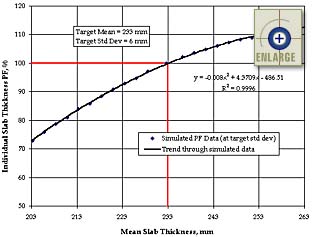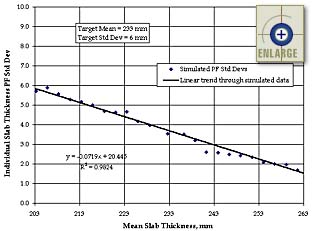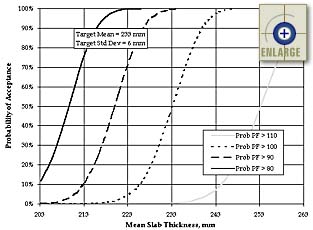Volume 1: Practical Guide, Final Report and Appendix A
After the agency makes all of the decisions required to
develop a project-specific PRS, the final step required before actually using the
specification is the generation of the appropriate preconstruction output. This
chapter is provided as a step-by-step guide to generating preconstruction output for both
Level 1 and Level 2 specifications.
Identifying Required Inputs |
A number of steps are the same whether the agency chooses a
Level 1 or Level 2 pay adjustment procedure. These steps require the collection of
much project-specific information required to conduct LCC simulations. The specific
steps for identifying the required inputs are detailed below.
Step 1—Define the General Project Information. The general
project information should be identified as a first step. This information includes
items such as project location, lane configuration, starting and ending stations, and lane
widths. These are selected in accordance with the guidelines presented in the
section titled
Design-Related
Variables, in chapter 5 of this volume.
Step 2—Define Pavement Performance. The agency must select the
distress indicators that will be used to define pavement performance. These are
selected in accordance with the guidelines presented in the section titled
Defining Pavement Performance,
in chapter 5 of this volume.
Step 3—Select the AQC's to be Included in the Specification.
The agency must select the AQC's that are to be sampled and tested for
acceptance. These are selected in accordance with the guidelines presented in the
section titled
Selection of
Included AQC's, in chapter 5 of this volume.
Step 4—Define the Required Constant Values. A number of
design-, climatic-, and traffic- related variables must be defined for use in the chosen
distress indicator models. These are selected in accordance with the guidelines
presented in the section titled
Identification of
Constant Variable Values, in chapter 5 of this volume.
Step 5—Define the AQC Acceptance Sampling and Testing Plan.
The agency must define the sampling and testing procedures to be used in measuring the
AQC's in the field. This plan not only defines the actual required sampling and
testing methods to be used, but also defines the number of samples per sublot, the methods
for determining random sampling locations, and some general information on
retesting. The defined acceptance sampling and testing plan is determined in
accordance with the guidelines presented in the section titled
Selecting
an AQC Acceptance Sampling and Testing Plan, in chapter 5 of this volume.
Step 6—Define the Required As-Designed AQC Target Values. The
agency must select as-designed target means and standard deviations for each of the
included AQC's. (Note: The selected means and standard deviations are dependent
on the selected sampling and testing plan—defined in step 5.) Guidelines for
selecting appropriate target values (interpreting existing specifications or from
historical AQC construction data) are presented in the section titled
Selection of AQC Target Values,
in chapter 5 of this volume.
Step 7—Define Lots and Sublots. Lots and sublots must be
clearly defined for the project. This primarily consists of defining the target
lengths of each. The definitions for both lots and sublots are determined in
accordance with the guidelines presented in the section titled
Definition of Lots and Sublots,
in chapter 5 of this volume.
Step 8—Define the Maintenance and Rehabilitation Plan. The
agency must select an appropriate M & R plan to be used for the specific project.
This involves selecting the type and frequency of application for maintenance,
localized rehabilitation, and global rehabilitation activities. The defined M &
R plan is determined in accordance with the guidelines presented in the section titled
Selecting a
Maintenance and Rehabilitation Plan, in chapter 5 of this volume.
Step 9—Define the Included Costs. The agency must identify the
particular costs to be included in the overall lot LCC. These decisions include
identifying the M & R unit costs associated with the chosen M & R activities,
deciding on an appropriate percentage of user costs to be included, and determining an
appropriate discount rate. All of these cost-related decisions are made in
accordance with the guidelines presented in the section titled
Cost-Related Decisions, in
chapter 5 of this volume.
Step 10—Define the Simulation Parameters. In order to conduct
any LCC simulations for the as-designed or as-constructed pavement, the agency must define
the required simulation parameters, such as the number of simulation lots required to
simulate a lot LCC and the appropriate range of number of sublots per lot. These
simulation-related parameters are determined in accordance with the guidelines presented
in the section titled
Selecting
Simulation Parameters, in chapter 5 of this volume.
Step 11—Choose the Appropriate Pay Adjustment Procedure. The
agency must select one of two pay adjustment methods available in the prototype
PRS—Level 1 or Level 2. Level 1 should be selected for initial implementation
of PRS. This decision is made in accordance with the guidelines presented in the section
titled
Selecting
a Pay Adjustment Procedure (Level 1 or Level 2), in chapter 6 of this
volume. The details for each of these pay adjustment methods are explained
separately in the following sections.
Level 1—Generating Individual AQC Pay Factor Curves |
 |
 |
For the Level 1 specification, the preconstruction output
involves simulating data points making up the individual AQC pay factor charts. Each
AQC pay factor chart is made up of a series of pay factor curves (each specific to a
different AQC standard deviation) plotted over a chosen AQC mean range. Pay factor
regression equations are fit through the data making up each pay factor curve.
Individual AQC pay factors may then be determined using the developed regression equations
(or read directly from these charts) by knowing the as-constructed AQC lot means and
standard deviations. If the measured AQC standard deviation does not exactly match
that of one of the simulated pay factor curves, the pay factor is determined by
interpolating between the appropriate pay factor equations. An explanation of the
development of the Level 1 pay factor curves (and corresponding pay factor regression
equations) is contained in more detail in this section.
Level 1, Step 12—Simulate the As-Designed LCC. In order to
calculate pay factors for different hypothetical levels of as-constructed AQC quality, the
representative target as-designed LCC must first be simulated. The PaveSpec 2.0 specification
simulation software is used to estimate representative target as-designed LCC's for
the different numbers of sublots per lot chosen by the agency (see the section titled
Selecting Simulation Parameters,
in chapter 5 of this volume). For example, the agency may decide to simulate
as-designed LCC's for three different scenarios where the number of sublots per lot
would equal 3, 4, and 5. Each of these simulated LCC's (representing a specific
number of sublots per lot) is a function of many different agency-defined variables,
including the number of simulation lots, acceptance and sampling plan, M & R plan, AQC
target values, analysis life, and chosen costs. Individual Level 1 pay factor charts
will be developed independently for each scenario chosen by the agency.
Level 1, Step 13—Choose a Range of As-Constructed Means for Each AQC.
Reasonable ranges of AQC means are selected that will define the values used in the
simulation of the Level 1 AQC pay factor curves. These chosen ranges of AQC
simulation means are based on the chosen AQC target values. The agency is required
to define the range of the AQC means and the number of simulation points within the range.
The agency-chosen values will be used to define the x-axis range of the developed
Level 1 pay factor charts. It is recommended that the boundary conditions of this range be
defined as the agency-defined AQC RQL's and MQL's (see the section titled
Retesting Procedures in chapter 5
of this volume).
Level 1, Step 14—Choose a Range of As-Constructed Standard Deviation Levels
for Each AQC. The pay factor curves (contained in the Level 1 pay factor
charts) depend not only on the as-constructed AQC mean, but also on the as-constructed AQC
standard deviation. Therefore, it is important to choose a range of as-constructed
standard deviation levels that will show the influence of the AQC variability. Three
to five different levels of standard deviation are typically chosen for each AQC. (One of
the chosen standard deviation levels should always be the AQC target standard deviation.)
Level 1, Step 15—Simulate As-Constructed LCC's and Calculate an
Independent AQC Pay Factor for Each Hypothetical As-Constructed Mean/ Standard Deviation
Pair. The hypothetical as-constructed mean/standard deviation pair values
(coming from combinations of means and standard deviations defined in Level 1, steps 13
and 14, respectively) are used to define individual simulation sessions in PaveSpec.
Each AQC is investigated independently for each simulation session (e.g., if
strength is being investigated, all of the other AQC as-constructed means and standard
deviations are set equal to the target values). Each mean/standard deviation pair is
used in PaveSpec to simulate a corresponding representative as-constructed LCC mean
(AC-LCC
MEAN). A pay factor is calculated for each
hypothetical pair using equation 3
in chapter 3 of this
volume. (Note: Pay factors are calculated using an agency-selected appropriate bid
price determined in accordance with the guidelines set forth in the section titled
Selecting
an Appropriate Bid Price for Developing Level 1 Preconstruction Output in chapter
5.)
Level 1, Step 16—Determine Individual AQC Pay Factor Regression Equations.
Best fit regression equations are defined for each set of simulated pay factors
related to each as-constructed AQC standard deviation (chosen in Level 1, step 14).
These individual pay factor equations are generated using the PaveSpec 2.0 software.
Level 1, Step 17—Plot Pay-Factor Equations vs. AQC Mean. The
defined pay factor regression equations (determined in Level 1, step 16) can be graphed
easily as a function of the AQC mean. Pay factor charts (containing plots of all of
the regression equations defined in Level 1, step 16) are then plotted for each AQC
independently. These charts are created for each number of sublots per lot chosen by
the agency (see the section titled
Selecting Simulation Parameters
in chapter 5 of this volume).
Level 1, Step 18—Define the CPF Equation. The agency must
define a governing CPF equation in accordance with the guidelines presented in the section
titled
Defining
a Level 1 Composite Pay Factor Equation, in chapter 6 of this volume.
Level 1, Step 19—Define Pay Factor Limits. The agency must
define pay factor limits that are applied to the computed individual AQC pay factors, or
the lot CPF, or both. Any chosen pay factor limits are determined in accordance with
the guidelines presented in the section titled
Selecting Pay Factor Limits,
in chapter 6 of this volume.
Level 2—Simulating the As-Designed LCC |
 |
 |
For a Level 2 specification, the preconstruction output only
involves the simulation of the target as-designed life-cycle cost (LCCDES).
Overall lot pay factors are calculated directly as a function of this LCCDES,
the determined as-constructed LCC (LCCCON), and the contract bid
price (using equation 3 in chapter 3 of this
volume). This Level 2 LCCDES is determined using the same
procedure described in Level 1, Step 12.
Developing Operating Characteristic Curves |
 |
 |
Under the Level 1 PRS, operating characteristic (OC) curves
are generated for each AQC using the PaveSpec 2.0 computer software. Each set of OC
curves is developed specific to a defined sampling plan (i.e., number of sublots, number
of samples per sublot, and sample and test types). The following steps outline the
general procedure used within the software to generate these charts:
For each AQC, the following applies:
- Distributions of pay factors for different AQC mean values (over the chosen range of AQC
means) are simulated by setting the as-constructed AQC standard deviation equal to the
target value. Each distribution is the result of a minimum of 500 simulated lot pay
factors.
- Pay factor means and standard deviations (computed at each hypothetically
chosen AQC mean) are plotted over the chosen range of AQC means. Relationships of
pay factor mean and pay factor standard deviation versus AQC mean are determined.
Figures 20 and 21 illustrate these respective relationships for slab thickness on an
example project. Figure 20 is commonly referred to as an expected pay (EP) curve.
- The user must define the different pay factor acceptance levels for which the
probability of acceptance will be investigated (e.g., PF ³
80%, PF ³ 100%, PF ³ 110%).
- Finally, OC curves for each of the chosen pay factor acceptance levels are
plotted using the results of steps 1 through 3. Figure 22 contains the example OC
chart plotted using the relationships determined for the slab thickness example
(determined in step 2).
 |
| Figure 20. Example of a simulated pay factor mean versus AQC mean
relationship used to develop OC curves for a Level 1 PRS. |
 |
| Figure 21. Example of a simulated pay factor standard deviation
versus AQC mean relationship used to develop OC curves for a Level 1 PRS. |
 |
| Figure 22. Example of an OC curve constructed for a Level 1
PRS—case of four sublots and two samples per sublot (for each AQC). This chart
reflects the relationships presented in figures 20 and 21. |
Different examples of interpreting figure 22 are given as
the following:
- If the contractor wishes to have a 50-percent probability that he/she will obtain a PF ³ 100 percent, then a mean slab thickness of 233 mm must be
constructed.
- If the contractor wishes to have a 90-percent probability that he/she will obtain a PF ³ 100 percent, then a mean slab thickness of 240 mm must be
constructed.
- If the contractor wishes to have a 90-percent probability that he/she will obtain a PF ³ 110 percent, then a mean slab thickness of 260 mm must be
constructed.
- f the contractor actually builds a mean slab thickness of 223 mm (the
target was 233 mm), the probability that he/she will receive a PF ³ 100
percent is approximately 5 percent. The probability that he/she will receive a PF ³ 90 percent is 70 percent.



